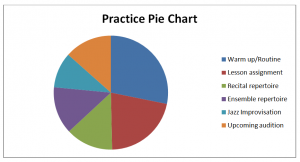As we get older and (hopefully!) develop musically it seems that the demands on our time and playing increase exponentially. There never seems to be enough time in the day for everything that I want/need to work on. Coming up with a method of organizing my practice time has helped me tremendously. When I observe this “pie chart” practice methodology I feel a sense of accomplishment at the end of a practice session, rather than “Oh &^@#, I’m out of time and I didn’t even get to ___ .” This was me a lot, especially the swearing part, until I categorized my practice time.
This chart (click on it to enlarge) represents what might be on the “practice plate” for a typical college trumpet major. There are a number of musical “balls that they have to keep in the air” any given semester. I have had a lot of students feel like they are getting pulled in all different directions, playing all the time but not quite doing anything as well as they would have wished.
Create a list of your musical obligations and place them in a pie chart such as the one above. The nice thing about a pie chart is the visual stays the same whether that chart represents a 2-hour practice session or a 20-minute session. You will always be addressing all of your obligations. If you are feeling like you are slighting or falling back in one of your obligations I encourage you to expand the overall time of the practice session so the pieces of the pie remain in proportion.
A lot of players find it helpful to have shorter, multiple practice sessions. If that works for you then create multiple charts. So instead of hitting all six categories each session, have a chart with say, three categories for each session.

